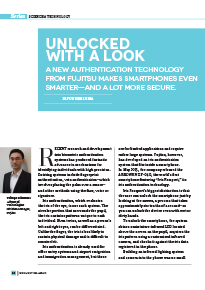Home > Highlighting JAPAN >Highlighting Japan June 2015>Science & Technology
Highlighting JAPAN

Science & Technology
Unlocked with a Look
A new authentication technology from Fujitsu makes smartphones even smarter—and a lot more secure.

Recent research and development into biometric authentication systems has produced fantastic advances in mechanisms for identifying individuals with high precision. Existing systems include fingerprint authentication, vein authentication—which involves placing the palm over a sensor—and other methods using the face, voice or signature.
Iris authentication, which evaluates the iris of the eye, is one such system. The circular portion that surrounds the pupil, the iris contains patterns unique to each individual. Even twins, as well as a person’s left and right eyes, can be differentiated. Unlike the finger, the iris is less likely to sustain physical damage and is difficult to counterfeit.
Iris authentication is already used for office entry systems and airport emigration and immigration management, but these are for limited applications and require rather large systems. Fujitsu, however, has developed an iris authentication system that fits inside a smartphone. In May 2015, the company released the ARROWS NX F-04G, the world’s first smartphone featuring “Iris Passport,” its iris authentication technology.
Iris Passport’s biggest distinction is that the user can unlock the smartphone just by looking at the screen, a process that takes approximately six-tenths of a second—so you can unlock the device even with wet or dirty hands.
To unlock the smartphone, the system shines a miniature infrared LED located above the screen on the pupil, acquires the iris pattern using a customized infrared camera, and checks it against the iris data registered in the phone.
Building an infrared lighting system and camera into the phone was no small feat. Fujitsu’s Advanced Technologies Division Manager Takuya Kitamura, who is in charge of development, looks back on the process. “The space on a smartphone screen is a very congested area, equipped with the internal camera, antenna, receiver, different sensors and a variety of other parts, so placing an infrared lighting system and camera in there was a very difficult task.”
The fact that smartphones are used in all sorts of environments was also an essential point to consider during development, Kitamura says.
“An infrared camera’s precision can degrade if the camera becomes dirty, or from being outdoors and exposed to the infrared rays in sunlight. Blinking and camera shake also affect precision, so we’ve developed the system to photograph several images within an instant, and it chooses the optimal image for reading the iris pattern.”
Another consideration was allowing the position of the infrared lighting system and camera to be flexible enough to ensure that iris data could be acquired from a momentary glance at the screen, even at an angle. To safeguard the health of the eye, Fujitsu’s developers also provided a proximity sensor that would automatically shut the system off if the eye came too close to the infrared light.
Iris Passport features are not limited to just unlocking the security lock for your smartphone. By coordinating with a password manager, users can log into shopping website accounts and SNS services just by looking at the screen. There are also plans being considered for notebook computers and tablets equipped with similar features. Other possibilities on the horizon include instantly recognizing a driver the moment he or she sits in the car, allowing for customized seat positioning and musical selections.
Information security is needed throughout a wide range of situations, from smartphones—which are packed with personal information—to banks and interactions on the Internet. With this in mind, biometric authentication, which is safer and easier to use than passwords, will likely see rapid growth and proliferation in the future.
© 2009 Cabinet Office, Government of Japan






